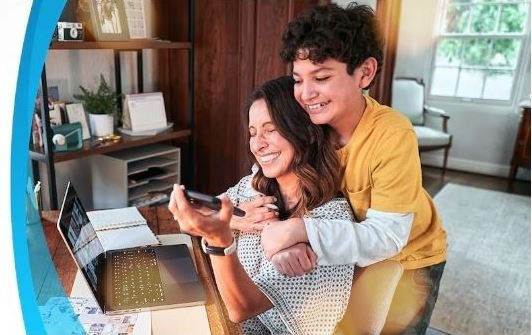Making the Leap to Streaming TV
How do you watch TV?
Sounds like a personal question but what I mean is: how does the information come to your
TV for you to watch. I bet it has changed a lot since you watched your first television set.
Appointment TV with Limited Programming
When I was a kid, my parents didn't want us watching much TV. They preferred that we read - and we could read whatever we wanted without censor. But TV was limited to 1 hour per week with preapproval required for the program (automatic approval was given for locally made shows as well as "The Brady Bunch" and "Mutual of Omaha's Wild Kingdom" for instance. Who can forget the quirky local homemade shows that made it onto your TV set (like "The Uncle Floyd Show")?

Certain shows - like "Bewitched" and "I Dream of Jeannie" - were off-limits due to majic (and too much skin shown on "I Dream of Jeannie"). Our TV was an 8 inch by 8 inch black and white with a long single telescoping antennae. (Just a side note, reading was in full color - lots of skin and majic too. But I digress).
The point is that we (you, me, President Nixon and Farrah Fawcett) all had to consult the TVGuide or the local paper's published TV schedule and make an "appointment" (so to speak) to sit and watch the show of choice at the time it was broadcast. And you only planned to watch shows that were on the channels you knew your antenae could access.

Cable TV - Expanded Programming but Still Appointment TV
Then cable provided an explosion of choices and channels to watch. Apparently cable was available in 1948, but most folks didn’t have cable until much later. By 1989, 53 million U.S. households received cable television subscriptions, with 60 percent of all U.S. households doing so in 1992. Cable was only available in town - where there was coaxle cabling underground or on telephone poles. Satellite TV was developed to provide similar programming to a more rural population. With cable/sattelite TV came the added expense and an overwhelming plethora of programming. You paid for it all, but could still only watch one or two things at a time and only what was on when you were available (appointment TV). It always seemed the best stuff was on when you were heading to bed or in the middle of the night. At some point, people started taping shows on their VCR so they wouldn't miss a show - and then there were stacked video tapes with hurredly hand scribbled labels. The tapes would be erased and taped over again. And again.

Anytime TV - On Demand TV
Digital video recorders (DVRs) appeared on the market in 1999 from ReplayTV and TiVo. These digital set-top devices allowed users to record television programs without the use of videotape. More versatile than the VCR, recording set-up and playback was also significantly easier. Soon the cable and satellite TV providers provided a DVR incorporated into their system.
The DVR allows us to store up shows as they are broadcast if we set the shows to be recorded. The challenge was that there was a limit to how much could be stored. I would find myself panicking because I was behind on watching "Ally McBeal" and would have to delete episodes so that there was room to record something else I wanted to see.
Then in 2007 , HTTP-based adaptive streaming was introduced by Move Networks. This new technology would be a significant change for the industry. One year later the introduction of HTTP-based adaptive streaming, many companies such as Microsoft and Netflix developed their streaming technology. Initially, this allowed the viewer to rent movies from home over an internet access device (Roku) from Netflix (rather than running to a Video Rental store or corner Kiosk) and eventually Amazon and the many platforms available today developed. Television shows became available through these platforms as entire series (such as "All My Children") with the evolution of each episode becoming available within a few days of their initial broadcast. And people began to eliminate their cable bill. Ok, my household eliminated our cable bill.
My household eliminated the cable bill in 2008 keeping only the internet but saving $149 per month by cancelling TV cable programming. Instead we bought a Roku ($99 for the unit) and signed up for Netflix, Amazon (Prime) and Hulu with a combined expense of $36 per month (still $113/month saving). At first it was awkward because we couldn't access local TV news. We quickly adjusted and purchased an antennae for about $100 at Walmart. What we soon realized was that if we heard multiple fire trucks racing around the neighborhood, there wouldn't be any information on the local TV station News for quite a while and we had to stay glued to the screen to catch it. But we could do a search on Google by typing in our neighborhood and adding "firetrucks". A site would pop up telling us where the fires were located. Immediately . We kept the antenna just in case we want to watch local TV (about 7 channels). I don't think we have watched it...at all.
On-Demand Streaming
So, what this means (for those of you who haven't really experienced this) is that I can log in to Netflix on my computer, my phone, tablet or TV and find a movie or a show I like (say Seinfeld) and watch it. I can watch the entire series - today if I want (I don't think there are enough hours in the day beacuse there are so many Seinfeld episodes). Or just an episode today and another...next year. I can watch an ongoing new series - like Yellowstone on Prime. I can see the latest episode a few days after the initial broadcast. The great thing is that I can watch EXACTLY what I want EXACTLY when I am available to watch it on the device I want to watch it. This is called On-Demand Streaming.
Live TV Streaming
Other video streaming options - Stream sports online
I found a really great article that walks through all the options:
How Does Your TV / Phone / Tablet / Computer Receive the Data / TV Shows & Movies
Let's get down to brass tacks. There are really two types of scenarios in regards to TV to consider:
1) Local Channels
2) All the other shows / movies / sports events (received through cable but now can get through streaming.
For Local Channels: These can be received by:
- Antenna: If you are in a good location for receiving local channel broadcasting, the only cost would be the purchase of the antenna which can run from $49.00 to $120.00 for the equipment.
- Cable
- Streaming Platforms now offer Live TV through a SmartTV, Roku on a regular TV or AmazonFire, or cast from your computer.

All the other shows can be received by:
- Cable
- Streaming Platforms now offer Live TV through a SmartTV, Roku on a regular TV or AmazonFire, or cast from your computer.
For Streaming TV Platforms (Netflix / Hulu / Amazon Prime / Disney+ / etc), you would need:
A: The Internet. You need to have good data with high limits for this to work. If you are cutting out the cable, you can afford a more robust internet data plan. If you are limited on data due to your rural location (and let's assume Satellite is your only or best option), here is a possible solution:
B: The Device: Roku, Amazon Fire Stick, or Computer (On your computer, you can sign up for the service - Hulu, Netflix, Amazon Prime etc - and cast the picture from the computer to your TV).
C: Subscription to Streaming Service(s): You will need to sign up for Individual programming service (like Netflix, Roku, Amazon Prime) or a group of services in a package. I recommend this article for reviewing options and selecting what works for you: 10 Best Live Streaming Services . When my household made the switch, we signed up for Netflix, Hulu, and Amazon Prime and that has met our needs (since 2008).
You can always add on more programming services or switch to a package deal.
Keeping Cable
Not everyone is ready for this leap. So if you are keeping your traditional cable type service (which we might call traditional but has been only been in place since the late 80's for most of us), your choices are:
- Comcast (only in town) pricing is customized
- DirectTV (satellite based) starting at $74.99 / mo with DVR
- DishTV (satellite based) starting at $79.99 / mo with DVR
Plus the cost of internet into your home.
And as always, if you need some help navigating how to make this work, give us a call. We are here to help with all your internet and optimization concerns.


